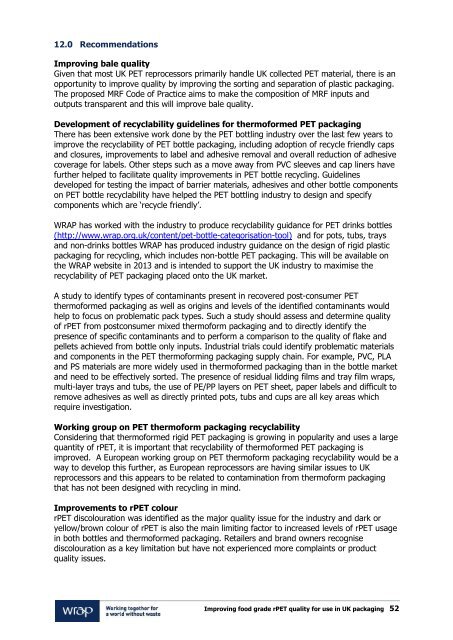rPET Quality Report
Create successful ePaper yourself
Turn your PDF publications into a flip-book with our unique Google optimized e-Paper software.
12.0 Recommendations<br />
Improving bale quality<br />
Given that most UK PET reprocessors primarily handle UK collected PET material, there is an<br />
opportunity to improve quality by improving the sorting and separation of plastic packaging.<br />
The proposed MRF Code of Practice aims to make the composition of MRF inputs and<br />
outputs transparent and this will improve bale quality.<br />
Development of recyclability guidelines for thermoformed PET packaging<br />
There has been extensive work done by the PET bottling industry over the last few years to<br />
improve the recyclability of PET bottle packaging, including adoption of recycle friendly caps<br />
and closures, improvements to label and adhesive removal and overall reduction of adhesive<br />
coverage for labels. Other steps such as a move away from PVC sleeves and cap liners have<br />
further helped to facilitate quality improvements in PET bottle recycling. Guidelines<br />
developed for testing the impact of barrier materials, adhesives and other bottle components<br />
on PET bottle recyclability have helped the PET bottling industry to design and specify<br />
components which are „recycle friendly‟.<br />
WRAP has worked with the industry to produce recyclability guidance for PET drinks bottles<br />
(http://www.wrap.org.uk/content/pet-bottle-categorisation-tool) and for pots, tubs, trays<br />
and non-drinks bottles WRAP has produced industry guidance on the design of rigid plastic<br />
packaging for recycling, which includes non-bottle PET packaging. This will be available on<br />
the WRAP website in 2013 and is intended to support the UK industry to maximise the<br />
recyclability of PET packaging placed onto the UK market.<br />
A study to identify types of contaminants present in recovered post-consumer PET<br />
thermoformed packaging as well as origins and levels of the identified contaminants would<br />
help to focus on problematic pack types. Such a study should assess and determine quality<br />
of <strong>rPET</strong> from postconsumer mixed thermoform packaging and to directly identify the<br />
presence of specific contaminants and to perform a comparison to the quality of flake and<br />
pellets achieved from bottle only inputs. Industrial trials could identify problematic materials<br />
and components in the PET thermoforming packaging supply chain. For example, PVC, PLA<br />
and PS materials are more widely used in thermoformed packaging than in the bottle market<br />
and need to be effectively sorted. The presence of residual lidding films and tray film wraps,<br />
multi-layer trays and tubs, the use of PE/PP layers on PET sheet, paper labels and difficult to<br />
remove adhesives as well as directly printed pots, tubs and cups are all key areas which<br />
require investigation.<br />
Working group on PET thermoform packaging recyclability<br />
Considering that thermoformed rigid PET packaging is growing in popularity and uses a large<br />
quantity of <strong>rPET</strong>, it is important that recyclability of thermoformed PET packaging is<br />
improved. A European working group on PET thermoform packaging recyclability would be a<br />
way to develop this further, as European reprocessors are having similar issues to UK<br />
reprocessors and this appears to be related to contamination from thermoform packaging<br />
that has not been designed with recycling in mind.<br />
Improvements to <strong>rPET</strong> colour<br />
<strong>rPET</strong> discolouration was identified as the major quality issue for the industry and dark or<br />
yellow/brown colour of <strong>rPET</strong> is also the main limiting factor to increased levels of <strong>rPET</strong> usage<br />
in both bottles and thermoformed packaging. Retailers and brand owners recognise<br />
discolouration as a key limitation but have not experienced more complaints or product<br />
quality issues.<br />
Improving food grade <strong>rPET</strong> quality for use in UK packaging 52



